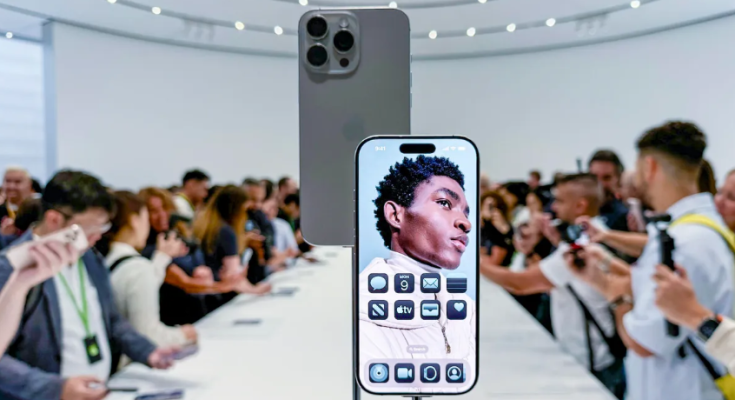iPhone 16 Pro Max Specs vs. Galaxy S24 Ultra: Big Phones Compared
How do Apple’s and Samsung’s biggest, best phones compare? Here are all the specs.

Apple has just taken the wraps off a host of new tech at its September launch event on Monday, including a new watch, AirPods and iPhone 16 range. The biggest phone in the bunch remains the iPhone 16 Pro Max, which will be going toe-to-massive-toe with Samsung’s biggest flagship, the Galaxy S24 Ultra. Both phones have a lot to offer to those of you who love sizable devices, but how do the two compare on paper? Let’s take a look at the specs.
Starting with the obvious part; the screen. Apple crept ahead here (assuming you think bigger is better, that is) upping its iPhone 16 Pro Max to 6.9 inches, over last year’s 6.7 inches. At 6.8 inches, the S24 Ultra is ever so slightly smaller than Apple’s phone, but I can’t imagine you’d ever notice that 0.01-inch difference. The S24 Ultra does have a higher pixel density (501ppi vs. 460ppi) but we’ll have to wait to see how they actually compare in use when we can put the two side by side.
More from the Apple event
Samsung’s phone is powered by a Qualcomm Snapdragon 8 Gen 3 chip, while Apple’s phone runs on its own in-house silicon. In this case, a brand-new A18 Pro chip, which Apple promises will deliver better power efficiency and performance for gaming and AI. Given that the iPhone’s consistently dominate benchmarks — especially graphics ones — it’s fair to assume that the new chip will be a powerhouse. But it’ll certainly be interesting to see how the scores stack up.
Turning to the rear cameras, the iPhone packs the usual trinity of main, ultrawide and 5x telephoto zoom lens, while the S24 Ultra hits back with its main, ultrawide, and 3x and 5x telephoto zooms. On paper, Samsung’s phone should be the ultimate photography powerhouse — especially with its whopping 200 megapixel main sensor — but Apple’s phones have always taken some of the best images around. The inclusion of ProRaw images and ProRes video — including the new 4K slow motion shooting — means that the iPhones will still be a top contender with enthusiastic photographers.
Beyond that, there’s less to pick apart at this point. Both phones offer up to 1TB of storage, neither allows you to expand the storage and both use titanium in their designs, offering IP68 water resistance. How well the phones really compare remains to be seen in our full review.
iPhone 16 Pro Max specs vs. Galaxy S24 Ultra
| Apple iPhone 16 Pro Max | Samsung Galaxy S24 Ultra | |
| Display size, tech, resolution, refresh rate, brightness | 6.9-inch OLED Super Retina XDR display; 2,868 x 1,320 pixel resolution | 6.8-inch AMOLED; 3,120×1,440 pixels; 1-120Hz adaptive refresh rate |
| Pixel density | 460 ppi | 501 ppi |
| Dimensions (inches) | 6.42 x 3.06 x 0.32 inches | 6.40 x 3.11 x 0.34 in. |
| Dimensions (millimeters) | 163 x 77.6 x 8.25mm | 163 x 79 x 8.6 mm |
| Weight (grams, ounces) | 227 g, 7.99oz | 233g (8.22 oz.) |
| Mobile software | iOS 18 | Android 14 |
| Camera | 48MP fusion camera, 48MP ultra-wide camera, 5X telephoto | 200-megapixel (wide), 12-megapixel (ultrawide), 10-megapixel (3x telephoto), 50-megapixel (5x telephoto) |
| Front-facing camera | 12MP TrueDepth camera | 12-megapixel |
| Video capture | 4K up to 120fps; spatial video at 1080p at 30fps | 8K |
| Processor | A18 Pro | Qualcomm Snapdragon 8 Gen 3 |
| RAM/storage | 256GB, 512GB, 1TB | 12GB RAM + 256GB, 512GB, 1TB |
| Expandable storage | No | No |
| Battery/charging speeds | Up to 33 hours video playback; up to 29 hours video playback (streamed). 20W wired charging. MagSafe wireless charging up to 25W with 30W adapter or higher; Qi2 up to 15W | 5,000 mAh |
| Fingerprint sensor | None (Face ID) | Under display |
| Connector | USB-C | USB-C |
| Headphone jack | No | No |
| Special features | Apple Intelligence, Action Button, Camera Control button, 4x audio mics, Dynamic Island, 1 to 2000 nits display brightness range, IP68 resistance, titanium frame colors: Black Titanium, White Titanium, Natural Titanium, Desert Titanium | Titanium frame, 2,600-nit peak brightness; 7 years of OS and security updates; 5G (mmWave); IP68 water and dust resistance; wireless PowerShare to charge other devices; integrated S Pen; UWB for finding other devices; 45W wired charging (charger not included); Galaxy AI; Wi-Fi 7; Gorilla Glass Armor cover glass |
| US price off-contract | $1,199 (256GB), $1,399 (512GB), $1,599 (1TB) | $1,300 (256GB) |
| UK price | £1,199 (256GB), £1,399 (512GB), £1,599 (1TB) | £1,249 (256GB) |
| Australia price | AU$2,149 (256GB), AU$2,499 (512GB), AU$2,849 (1TB) | AU$2,199 (256GB) |
![]()
The Pixel 9 Pro and Pro XL have impressed me already with their fancy new designs and wealth of AI skills. And while the cameras put in a solid performance during my initial testing, the true test is to see how they stack up against the chief rivals. I’ve been out shooting hundreds of images across Edinburgh on the Pixel 9 Pro, side-by-side with Apple’s iPhone 15 Pro Max to see how these two pricey flagships compare when it comes to photography prowess.
On paper the Pixel punches harder, with a marginally higher-resolution main camera (50 megapixels over the iPhone’s 48 megapixels), and both its telephoto and ultrawide cameras offer 48 megapixels of resolution over Apple’s 12 megapixels. Still, more megapixels don’t mean better images and Apple is well-known for using its software processing to produce some of the best-looking photos it’s possible to get from a phone. It’s going to be an interesting battle.
Read more: Apple’s ‘Glowtime’ iPhone 16 Event: What to Expect and How to Watch
From blue-sky days to dark nights, I’ve tested the phones in a variety of scenarios, putting all the lenses to the test to see which one comes out on top. All images have been taken in JPEG using auto settings in the default camera app, unless otherwise stated.


Starting with this challenging outdoor scene, both phones have done exceptionally well, with excellent exposures in the bright sky while retaining plenty of shadow detail in the foreground. The iPhone’s shot has a warmer color balance, which I prefer, along with deeper shadows that look more natural to my eye.


In this more shaded outdoor scene, the iPhone has delivered a brighter front to this pub, with the Pixel 9 Pro XL looking muted by comparison. Both shots are packed with detail, however.


Although both shots of these flowers were taken at a distance using the main camera, the Pixel’s shot seems to have created some background blur around the central white flowers which I’m not especially keen on. The iPhone’s shot has kept more of the scene in focus. That said, I feel the Pixel’s white balance may be more natural, with the iPhone’s warmer tone adding a yellow-green tinge to the flower petals.


The Pixel’s slight magenta bias in the white balance is more prominent here, with the color tone look appearing more natural in the iPhone’s image. The iPhone has also captured a brighter shot here, with better-looking contrast on the details on the brickwork and tiles of the structure.


While both shots of this harbor scene are well exposed, there’s a significant difference in the color balance, with the water in the Pixel’s shot looking brown compared with the iPhone’s image. While I prefer the iPhone’s water, the colors on the boats and the sky looks nicer in the Pixel’s shot, so I guess I need to mash both together in Photoshop to get the image I really want.


Compared to the iPhone’s shot, the Pixel appears to have a more noticeable magenta shift in its white balance, although the image overall appears brighter, with slightly more contrast.


The Pixel’s color balance appears more natural when using the ultrawide camera and I prefer its brighter exposure.
Telephoto zoom comparison


Both phones offer 5x optical zooms, delivering crisp shots at full resolution without having to digitally crop in at the expense of detail. While I prefer the exposure and contrast of the iPhone’s shot here — the Pixel has lifted the shadow detail to an unrealistic extent here — the Pixel’s image has nicer-looking details. Zooming in on fine details shows that the iPhone’s image suffers more from image sharpening, giving some areas a “crunchiness” that the Pixel’s image doesn’t suffer from.


It’s much the same story here, with the Pixel’s image looking artificially brightened against the iPhone’s more natural-looking scene. However, the Pixel’s details are better-looking when viewed up close, with better definition on some of the textures on the building in the distance. Evidently the Pixel 9 Pro’s significantly higher-resolution telephoto camera sensor is shining through here, providing more detail without having to lean too much on digital sharpening.


Again, the Pixel’s shot is brighter than the iPhone’s, although here I do think it simply looks better as a brighter image, rather than looking unnatural. As with the previous examples, the Pixel’s higher resolution sensor also shows cleaner details when viewed close up.
Night mode comparison


At night, things take a dramatic turn. While both shots have similar levels of exposure and contrast, the iPhone’s image has better details in all areas. Fine details on the boat look sharper and while the Pixel’s noise reduction algorithm has smoothed out the rough, pebble-dashed texture of the buildings on the left, the iPhone has maintained that texture. But despite losing a lot of texture elsewhere, the Pixel’s image still suffers more from image noise in the sky, with noticeable “blotchy” areas, while the iPhone’s sky looks much smoother.


There’s less to choose between the two when using the night mode with the ultrawide lenses, although the iPhone’s image has a slight edge when it comes to sharper details. The Pixel’s aggressive noise-reduction algorithm continues to smooth out details that should remain, resulting in a lack of detail on areas of brickwork on buildings.


With sharper details and less image noise overall, the iPhone takes a clear victory when shooting night mode scenes using the 5x optical zoom lens.


It’s important to also check that the 5x telephoto lens has actually been activated. While I switched to the lens to take this shot, I was confused about why the quality was so much worse than I expected — even the “Plumbase” sign, which is clearly readable in the iPhone’s image, looks like incomprehensible nonsense in the Pixel’s shot.
Looking at the image metadata, it looks like when I pressed to zoom in, the phone simply cropped into the main sensor, rather than swapping to the telephoto sensor, which would account for the astonishing drop in quality. Whether this is an early teething bug that will be ironed out with updates remains to be seen, but always make sure to check that the lens you want is definitely the one you’re using.


That said, the Pixel’s telephoto zoom performed far better here, so its performance may be better described as “hit and miss” at night. It’s a decent shot, though it again falls behind the iPhone for overall details.
Panorama, selfie and macro camera comparison


The Pixel 9 Pro series has an updated panorama function, designed to produce better-looking shots, but I prefer the iPhone’s effort here — it has a wider view, better contrast and punchier colors. Yes, the Pixel’s shot has slightly more detail when you peek up close, but the iPhone’s looks better overall and hasn’t actually sliced the fence in half on the left of the walkway. So the iPhone wins.


While the Pixel 9 Pro XL’s selfie camera has been bumped from 12 megapixels on its predecessor to a much more generous 42 megapixels, I honestly can’t tell any difference in detail between it and the iPhone 15 Pro Max’s 12-megapixel front camera. In fact, the iPhone’s detail exceeds the Pixel’s in various spots as the Pixel’s heavy-handed noise reduction again smooths out areas where texture should be, making the image look less detailed as a result.
I prefer the brighter tones on my face in the iPhone’s image too, although the iPhone’s tighter field of view might not be to everyone’s taste, especially if you’re trying to squeeze lots of friends into the shot.


You can switch to wider-angle views on both phones, though it’s got to be said that the iPhone’s wide-angle view looks about the same as the Pixel’s standard view. The Pixel’s wide mode is wide, giving you loads of room to fill the frame with smiling family and friends instead of standing alone on a footpath on a rainy day in Scotland. Again, there’s little difference in details but I do prefer my brighter face on the iPhone’s shot.


Both phones have a macro mode that uses the ultrawide camera for close up focusing. I’m disappointed with the Pixel’s effort here; the colors look drab, the blurred background looks artificial — almost like motion blur — and the actual detail on the fly and the flower it’s on is superior on the iPhone.
Raw image comparison


One area I still find the Pixel 9 Pro lacking is in its raw image capture. On last year’s Pixel 8 Pro I found its raw files were fuzzy-looking and difficult to work with in raw image editors like Adobe Lightroom. The Pixel 9 Pro’s raw capture is better, but it’s still not great. Details are soft, with an almost hazy effect around them that takes a lot of additional sharpening to get back to a usable point.
The iPhone’s ProRaw continues to be superb, offering exceptional image quality with a lot of latitude to push shadows, pull back highlights and play with color toning without noticing image degradation. I’ve tried to match the edits on these two raw files and my workflow on the iPhone’s shot was straightforward. The Pixel took a lot more work.
I might be a niche case, but raw capture is crucial for me on a phone. As a professional photographer, I want to ensure I’m capturing the best possible quality in my images, with enough scope to edit the files later as I would with any images from my professional camera. The iPhone allows me to do that, but I wouldn’t be happy using the Pixel’s raw files in a more professional context.

Which phone takes better pictures?
It’s been a close match, with each phone surpassing the other in different ways. I’m impressed at the Pixel’s overall image quality, with its daytime shots often producing more detail — and sometimes more natural color tones — than the iPhone. However, I frequently don’t like how much the Pixel lifts the shadows in its HDR processing, which I find looks quite unnatural. At 5x zoom, the Pixel’s images have better details than the iPhone’s, likely thanks to the higher resolution sensor.
But the iPhone delivers superior results in most nighttime tests, and when using the panorama and macro modes. I even prefer the selfie camera on the iPhone, but the Pixel’s much wider angle may well be a point in its favor for you.
Overall it’s difficult to pick which one is “best” out of the two as it’ll likely come down to what you want from your phone. If, like me, you’re a professional photographer, or even just an extremely enthusiastic amateur, the iPhone’s less heavy-handed processing produces more natural shots. Its raw files are also worlds apart, so if you do a lot of image editing, the iPhone is the way to go.
But if you’re after something that can simply take great-looking shots in most conditions for you to share to social media straight from your phone, the Pixel 9 Pro is one of the best camera phones around.
The Pixel 9 Pro XL’s New Design Is One of My Favorite Things About It




